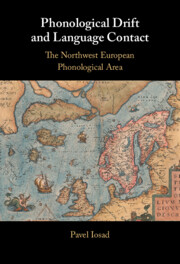
- Publisher:
- Cambridge University Press
- Online publication date:
- June 2025
- Print publication year:
- 2025
- Online ISBN:
- 9781108608855

Several language families of northern Europe – Germanic, Celtic, and Uralic – share phonetic and phonological patterns that are typologically unusual. This book demonstrates how we can better understand these convergences: they exemplify the phenomenon of drift. Using the latest advances in theoretical linguistics, the study of sound change, and language variation, it offers insights into the development of these features and what they tell us about past cultural and linguistic contacts. Although the languages are not closely related, an understanding of drift grounded in the theory of the life cycle of phonological patterns reveals the workings of convergent developments. Covering a wide range of vernacular varieties, this book shows how phonological microvariation is illuminated by an approach grounded in the theory of the life cycle and historical sociolinguistics. It is essential reading for historical and theoretical linguists, and anyone with an interest in the cultural and linguistic contacts across northern Europe.
‘This is an important book. I’ve been working on the empirical and theoretical issues treated here my whole career and I learned a lot from Iosad’s discussion. It provides real progress on and refinement of the long-problematic notion of ‘drift’ and applies that to prehistoric Northern Europe in a sober and compelling way.’
Joe Salmons - Professor of Language Sciences, University of Wisconsin–Madison
‘Immensely learned, empirically hefty, theoretically cutting-edge, Iosad's rethinking of phonological areality is utterly compelling.’
Ricardo Bermúdez-Otero - University of Manchester
‘The book offers a comprehensive case study of language contact in north-western Europe, contextualized within linguistic typology, traditional views, and contemporary theoretical frameworks. Iosad brings together both extensively documented and lesser-studied languages to present a compelling account of the synchronic and diachronic dimensions of pre-aspiration as an areal feature. Finally - and refreshingly - the book is a genuine pleasure to read.’
Darya Kavitskaya - Professor of Slavic Languages and Literatures and of Linguistics, UC Berkeley
 Loading metrics...
Loading metrics...
* Views captured on Cambridge Core between #date#. This data will be updated every 24 hours.
Usage data cannot currently be displayed.